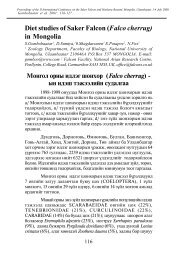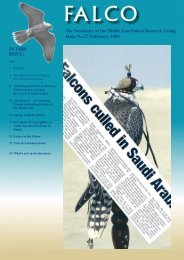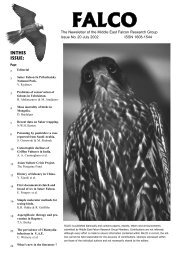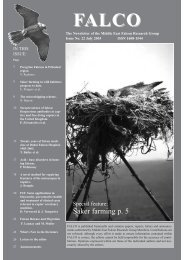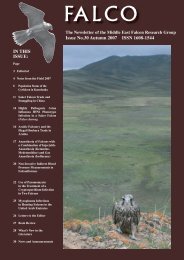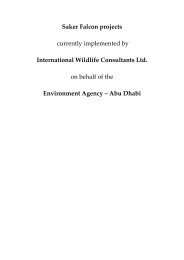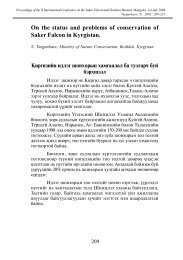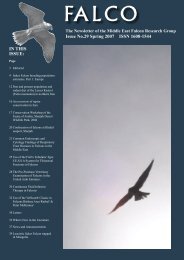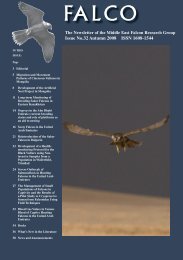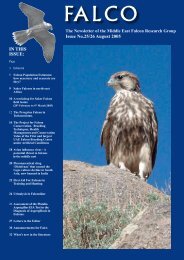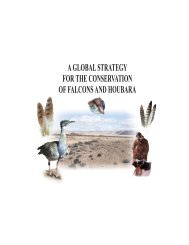Falco cherrug - International Wildlife Consultants Ltd.
Falco cherrug - International Wildlife Consultants Ltd.
Falco cherrug - International Wildlife Consultants Ltd.
You also want an ePaper? Increase the reach of your titles
YUMPU automatically turns print PDFs into web optimized ePapers that Google loves.
Trichomonas: common in owls when ears, nasal cavity<br />
and brain involved. Diagnosis detection of flagellates in<br />
fresh, wet preparations or stained smears. Treatment:<br />
metronidazole 50mg/kg orally once a day for 5 days and topical<br />
treatment and debridement of the oral lesions (Samour<br />
et al. 1995).<br />
Sarcocystis sp.: reported in a goshawk (Accipiter<br />
gentilis). Difficult to diagnose in live birds, (Post mortem<br />
and immunohistochemistry are needed) (Aguilar et al.<br />
1991).<br />
Toxicoses:<br />
Lead: the most common poisoning seen in raptors,<br />
first signs include leg weakness, the bird rests on its hocks with<br />
medial rotation of the feet. Treatment: sodium calcium edetate<br />
10-40mg/kg twice a day for 5 to 10 days, gastric lavage if necessary<br />
and supportive treatment. Other heavy metals associated<br />
with raptor poisoning include zinc, cadmium, and mercury.<br />
Pesticide poisoning: strychnine, alphachloralose,<br />
organochlorines, organophosphates and acetyl cholinesterase.<br />
Post mortem toxicology gives the definitive diagnosis in these<br />
cases. Treatment is symptomatic, for acetyl cholinesterase<br />
atropine 0.1mg/kg IV or IM every 3-4 hours have been proven<br />
to be effective.<br />
Trauma: clinical signs may include head tilt, tremors,<br />
seizures, ataxia, paresis or paralysis and may depend on the<br />
severity of the traumatic incident. Treatment is supportive.<br />
Corticosteroids (dexamethasone 1mg/Kg IM or SC, prednisolone<br />
2-4mg/kg IM) on a very short-term basis due to side<br />
effects. The use of diuretics may be beneficial for head trauma<br />
cases.<br />
Supportive treatment for birds presenting CNS neuropathy<br />
involves maintaining the bird in a dark, quiet and<br />
cool room, if seizures are present use benzodiazepine (midazolam<br />
0.5-1mg/kg IV or IM is preferred to diazepam<br />
0.5mg/kg IV or IM), fluid replacement therapy, empirical<br />
course of antibiotics and B vitamin complex may also be<br />
administered.<br />
PNS neuropathies<br />
Nutritional diseases:<br />
Vitamin E and Selenium deficiency: straddle legs,<br />
weakness and limbs paralysis observed. Treatment is vitamin E<br />
3.4 iu/bird and selenium 0.05mg/bird.<br />
Riboflavin (vitamin B2) deficiency: curled toe paralysis<br />
and atrophy of musculature of the legs. Treatment is B vitamin<br />
supplementation in the food, sometimes confused with<br />
hypovitaminosis E, consequently treat for both conditions.<br />
Thiamine (vitamin B1) deficiency: causes partial or<br />
complete paralysis of the legs. Treatment is vitamin complex<br />
supplementation in the food.<br />
Infectious diseases:<br />
Marek’s disease: commonly the sciatic nerve is affected<br />
and appears enlarged, oedematous and grey colour. MDV<br />
infection causes a lymphocytic infiltration and proliferation of<br />
the peripheral nerves resulting in paresis or paralysis.<br />
Aspergillus sp.: Aspergillus fumigatus. Lesions<br />
involving the PNS include pyogranulomatous inflammation<br />
and necrosis of the vertebrae, sacral plexus and soft tissues<br />
including the sciatic nerve. Mycotoxins have been reported<br />
to affect the nervous system. Appropriate antifungal treatment<br />
should be given.<br />
Toxicoses: dysmetria and ataxia observed. See<br />
CNS toxicoses.<br />
Trauma<br />
Brachial plexus avulsion: Paralysis of the wing<br />
affected and muscle atrophy. No specific treatment, amputation<br />
of the affected wing may be an option.<br />
Spinal cord injuries.<br />
Posterior paresis due to pressure: result of adrenal,<br />
renal or gonadal enlargement or neoplasia. Other space<br />
occupying lesions such as egg binding may result in a<br />
peripheral neuropathy.<br />
Iatrogenic: damage of the brachial or sciatic nerve<br />
following surgery and injections.<br />
Post-Mortem examination<br />
A high proportion of bird with neuropathies will<br />
die or will have to be euthanased. It is important that a postmortem<br />
examination and full laboratory investigations are<br />
performed. Because of quick autolytic changes in the nervous<br />
system, it is essential to take the samples immediately<br />
after death.<br />
Brain material should be taken for histopathology,<br />
microbiology and toxicology.<br />
Portion from cervical and lumbar vertebral column.<br />
Peripheral nerves should also be taken: sciatic or<br />
brachial nerve. If thiamine deficiency is suspected the vagus<br />
nerve should be taken.<br />
Acknowledgement<br />
Thanks to Dr Tom Bailey for reviewing this paper.<br />
References<br />
Aguilar, R.F., Shaw, D.P., Dubey, J.P. & Redig, P. 1991.<br />
Sarcocystis-associated encephalitis in an immature<br />
Northern Goshawk (Accipiter gentilis atricapillus).<br />
Journal of Zoo and <strong>Wildlife</strong> Medicine. 22: 466-469.<br />
Beynon, P.H., Forbes, N.A. & Harcourt-Brown, N.H. 1996.<br />
Manual of Raptors, Pigeons and Waterfowl. British<br />
Small Animal Veterinary Association, Cheltenham, UK.<br />
Boydell, P. 1997. Nystagmus in Birds of Prey. Proceedings of the<br />
4 th European Conference on Avian Medicine and<br />
Surgery. Pp 220-222.<br />
Cooper, J.E. 2002. Birds of Prey: Health and Disease. Blackwell<br />
Science <strong>Ltd</strong>., USA.<br />
Forbes, N.A. 1987. Fits in the Harris hawk. Veterinary Record.<br />
120: 264.<br />
Heidenreich, M. 1997. Birds of prey: Medicine and Management.<br />
Blackwell Science <strong>Ltd</strong>., USA.<br />
Jones, M.P. & Orosz, S.E. 1996. Overview of Avian Neurology<br />
and Neurological Diseases. Seminars in Avian and<br />
Exotic Pet Medicine. 5: 150-164.<br />
Mundy, P.J. & Foggin, C.M. 1981. Epileptiform seizures in captive<br />
African vultures. Journal of <strong>Wildlife</strong> Diseases. 17: 259-<br />
265.<br />
Platt, S.R., Helmick, K.E., Graham, J., Bennett, R.A., Phillips, L.,<br />
Chrisman, C.L. & Ginn, P. E. 1999. Peripheral neuropathy<br />
in a turkey vulture with lead toxicosis. Journal of<br />
American Veterinary Medicine Association. 214: 1218-<br />
1220.<br />
Redig, P.T., Cooper, J.E., Remple, J.D. & Hunter, B. 1993. Raptor<br />
Biomedicine. University of Minnesota Press.<br />
Minneapolis, USA.<br />
Redig, P.T., Stowe, L. & Arent, T. 1980. Lead Toxicosis in Raptors.



